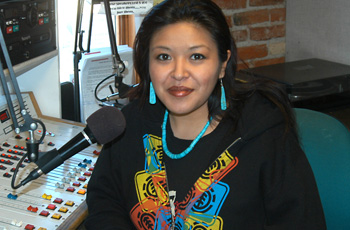SHAWL Society continues to advocate for clean up of uranium mines
Twa-le Abrahamson of SHAWL (Sovereignty, Health, Air, Water and Land) said Marco Kaltofen’s information is critical because there’s talk of producing more nuclear energy to reduce global warming and because nuclear waste cleanup is stuck in a blame game.
 |
Twa-le Abrahamson produces 'Native Voices' program |
“We need the contaminants cleaned up without worrying about who is responsible. There is no work being done now, because no one wants to take responsibility,” she said.
In December, Twa-le, who does the Inner Tribal Beat show on KYRS (92.3 FM) radio from 2 to 4 p.m., Tuesdays, was hired by the Spokane Tribe as air quality coordinator.
Along with doing radon testing and mitigation in the school and homes, she will address air quality issues when Super Fund remediation of uranium mines and mill sites on the reservation begins in two years. There will be construction to cap the mine and build a water treatment plant.
“Our tribe wants to be hired to help with the remediation, but we also need to monitor workers’ health,” she said. “Our goal is to protect the next generation as they work at the site.”
Twa-le reviewed the Spokane Tribe’s experience with uranium mining on the reservation in sites that are still contaminated. The tribe is one of the tribes targeted for uranium mining—in the Southwest, Black Hills and Alaska.
“There were promises of jobs and royalties made to the Spokane Tribe with development of the Midnite Mine in 1953,” she said.
The Sherwood Mine and Mill Site operated from 1978 to 1984, when there were regulations and funds to assure reclamation of the land. Even though the land was reclaimed, its 1,200 workers were not informed of the detrimental impact of radiation and toxins associated with uranium mining, Twa-le said.
The Midnite Mine and the Dawn Mill Site, which was 25 miles away, closed in 1981. The mine became a Superfund Site in 2000. There are difficulties with reclamation because the mining operations left open pits that penetrate the aquifer, creating perpetual seepage of contaminated water into two lakes that flow into Blue Creek and the Spokane River.
The mine yielded 2.9 million tons of high-grade uranium ore and left 35 million tons of waste.
The estimated cleanup cost is $280 million, Twa-le said.
Ore and yellow cake—concentrated uranium powder—were transported by truck from the Midnite Mine through tribal communities to the Dawn Mill Site. Safety measures were lax. Mining and milling provided work and income on the reservation.
“If workers’ badges showed their exposure exceeded the maximum, they often traded badges,” she said.
Her mother, Deb Abrahamson, who founded the SHAWL Society, said other indigenous communities around the world have also been exposed to toxins.
Yucca Mountain, once considered for a nuclear waste repository, is on indigenous lands, she said.
Eighteen indigenous, minority and racial communities—African American, Hispanic, Puerto Rican and Native American—are affected by the nuclear mining, processing and waste cycle.
“Now there are efforts to rebury the waste on our lands,” Deborah said.
The Dawn Mill was reopened in the 1990s to treat sludge from the Midnite Mine water treatment plant, because tailings in unlined ponds had been leaking pollutants into ground and surface water, and the soil.
In the early 2000s, SHAWL challenged efforts to bring waste to the site from areas that needed to be cleaned up on the East Coast Deb said. For example, people in New Jersey offered to help pay for cleanup there if they could transport their contaminated soil to the nearby Midnite Mine.
“We knew the lining was leaking,” she said. “We were able to stop the efforts to bring waste.”
SHAWL has spent years educating people on the effects of uranium mining and the need for cleanup because of damage to the health of miners and families, economic degradation and environmental damage.
Twa-le said many people have had several family members die of lung and other cancers, and kidney failure.
In addition, many suffer from respiratory problems and chromosomal damage from exposure through ingestion—eating and drinking—skin contact and inhaling radioactive particles and heavy metals in cultural and spiritual ceremonies of the sweat lodge and burning sage.
“There have been no measurements of exposure to contaminants through water, soil, air, subsistence foods, former workers, forestry workers, hunting and dust around the mine.
“Dust does not stay on the site,” she said. “When the price of uranium dropped, piles of ore were left there.”
Bob Brisbois, a Spokane tribal member, said his parents, grandparents and cousins all died of cancer. He wants exposure limited and health care funded.
Family and friends have tended to be silent, he said, absorbing the costs of health care by holding auctions, yard sales and dances to collect money to pay medical bills.
The 2,600 residents on this reservation suffer high health impacts from radiation and heavy metal contaminant exposure, said Deb, calling for a baseline study of the health impacts.
Risk of exposure is high because the subsistence lifestyle and the cultural/spiritual practices include hunting, fishing, gathering roots and berries, logging, sweatlodge and medicinal plant use.
Deb added that there is also concern that, while cleanup may bring economic development, when it stirs up dust, people inhale the particles, bringing a second wave of exposure to toxic effects to another generation.
“We have witnessed the loss of our older generation. Without knowing the cause and effect we cannot level justice,” she said. “We need to share information and continue to educate the public to help them connect the dots. We need to be informed so we can make wise decisions for the future.”
Deb and Twa-le are available to speak to groups to educate them about the Spokane Tribe’s experience.
For information, call 258-8952 or email shawlsociety@yahoo.com.
Copyright © March 2011 - The Fig Tree




